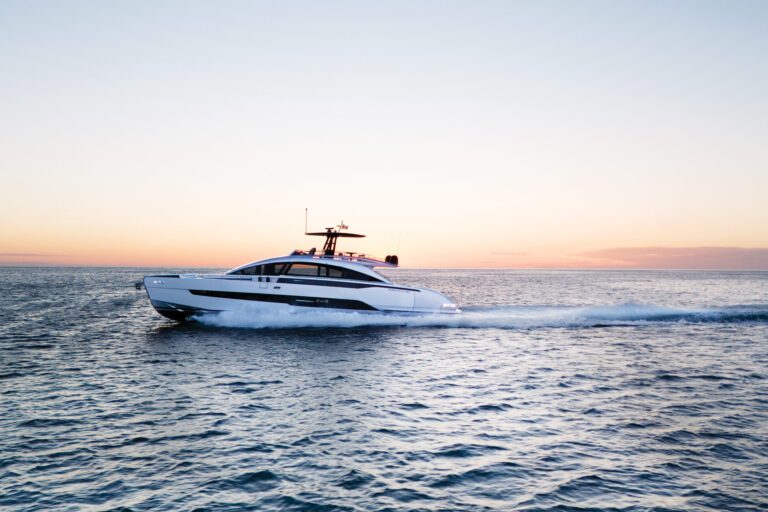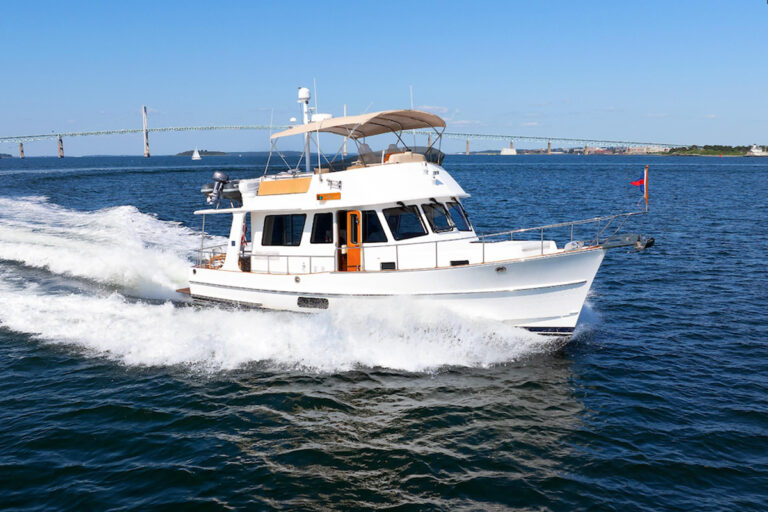When European boatbuilders began selling yachts geared toward Americans’ desire for interior space and savvy design, stateside boatbuilders took notice. Not wanting to miss out on the trend, Carver Yachts enlisted European design team Nuvolari & Lenard to create a model that would be Italian-made, but with American influence.
The result is the Nuvari Sonic 63, a build intended for the cruising couple who wants to travel in style with enough space to bring the whole family aboard. The collaboration between Carver and the Italians proved to be a success.
“We wanted to combine Italian design flair with Italian craftsmanship and U.S. engineering standards, so Italy was the logical place to build the new range”, said Robert van Grunsven, the head of Genmar’s yacht division and president of Carver.
The 63’s design is among the most well integrated on the market. The style flows from bow to stern without giving the impression that bits have been added on as afterthoughts. Carver and Nuvari wanted to offer high levels of customization with a huge range of options, so the European and U.S. versions are different. The main variation between the two is in the galley, which is on the main deck on the U.S. version. The wiring and generators also are continent-specific, but these differences do not affect the boat’s style. You can also specify a four-cabin layout for family use, but the three-cabin version on the boat I tested seemed very comfortable.
Underwater is a deep-V hull with enough deadrise to cushion the ride. Chines are modest in size to reduce hard impacts, and they extend outward as they run aft to improve stability, particularly in turns. A sweeping, low knuckle in the topsides runs low aft, creating almost a second chine. The result is a yacht that behaves herself, copes with changing sea conditions and produces the sort of dignified ride that should be a part of every yachting experience.
Even with a low bulwark around the deck, the topsides still appear in proportion. A knuckle in the topsides helps elongate the profile and keep spray under control. A solid-looking handrail, for security, tops the bulwarks. The stainless steel on the Sonic is the best I have seen-her custom after fairleads are almost a work of art. No wonder the builder uses stainless steel throughout the design.
The low arch abaft the sundeck emphasizes the flying bridge’s low lines, but it sets the radar antenna very low. As a result, people on the flying bridge could obstruct the radar picture. Otherwise, the area is designed for pleasure. Cabinets house the refrigerator and an electric barbecue. Forward are three seats at the helm and a couple of side seats, so everyone can look in on the progress of the boat. The low windscreen does a good job deflecting wind. Handrails are placed where needed, but the white surfaces here could cause some glare in the sun.
The curved teak steps from the helm are attractive and easy to use thanks to stainless-steel handholds in all the right places. The teak cockpit is similarly practical, with a central passerelle. Since the flying bridge is occupied, tender stowage is at the swim platform. Two fixed seats are in the cockpit, and a table and extra chairs tuck away in lockers just inside the saloon’s doors. Touches such as a locker for shoes, covered mooring facilities and an after control station add to the area’s appeal.
The quality of the saloon’s interior finish equals or surpasses the best of the Europeans. As on many yachts, cherry was selected for this area, but on the Sonic, a matte finish replaces the usual high-gloss lacquer. Burl provides a pleasing contrast on the furniture tops, and the décor has extensive wood inserts. Wood framing around the windows also helps raise the high-quality image.
The rucked leather settee to starboard faces a long curved bar counter, which, on the European version, hides the galley below. On the U.S. version, this counter forms the front of the galley. The galley has just a microwave oven rather than a proper one-a growing trend-but the electric stovetop is good. The area also includes a dishwasher and full-height refrigerator. Steps lead down to the utility room, which houses a freezer, laundry area and generous space for stowage.
Two steps up from the saloon is the dining area, which has a table with a curved settee and stools that can accommodate eight. Opposite is an internal stairway to the flying bridge, and forward is the lower helm. In contrast with the helm on the flying bridge, this one is a rather lonely place, with just a single seat facing the nicely laid-out dash. The seat is fully adjustable, and all controls are within easy reach. The wide windscreen pillars, however, restrict the view, and sun glare from the dashboard does not help.
The boat’s designers have resisted the temptation to cram in as many berths as possible. With just three staterooms, the Sonic’s accommodations are a joy-restful and embracing. You won’t want to leave the full-beam master stateroom, with its large berth and snug settee. Heads are finished in marble (a warm pink on our test boat) and are large enough for comfortable use. A twin cabin is to port, and forward is the VIP stateroom.
Twin 1,050 hp MAN diesels power this beauty to a top speed of more than 30 knots, and they feel comfortable cruising at around 27 knots. The engines are coupled with a conventional propulsion system that promises reliability, with a layout designed for easy access. Tucked abaft the engine compartment is an optional crew cabin complete with a tiny head. The cockpit’s seat cushions lift for access to this area.
The Nuvari 63 Sonic may be the new kid on the block, but she looks good, performs well and has that certain touch of magic that will help her stand out from her competitors.
Contact: Carver Yachts, (920) 822-1600; sales@hargrave-usa.com;www.carveryachts.com. For more information, contact: (866) 922-4877





